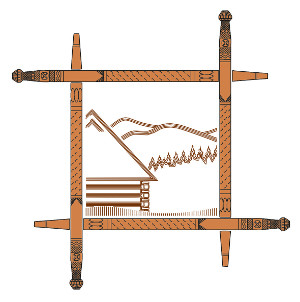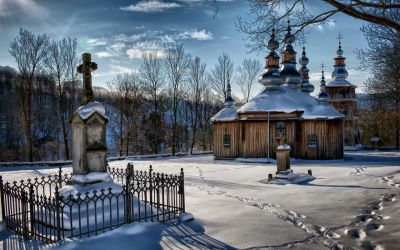Osława and Osławica valley
Opis produktu
ROUTE NAME: Osława and Osławica valley
ROUTE TYPE: car trail
ROUTE TARGET GROUP: route recommended for organised groups, individual tourists
DIFFICULTY LEVEL: route for beginners
ROUTE COURSE:
Komańcza – Osławica – Łupków – Nowy Łupków – Smolnik – Mików – Duszatyn – Prełuki – Rzepedź – Turzańsk
ROUTE DESCRIPTION:
Day 1
The trip starts in Komańcza - a village founded under Vlach law. In good weather, it is worth to walk part of the educational trail which starts next to the Greek Catholic Orthodox church from 1988, right by the road. We start on the main road next to the church and follow the trail marks. We can see a xerothermic grassland where we will find, among others, such species of plants as: veronica gentianoides, trifolium montanum, potentilla pusilla, orchis mascula or listera ovata. Next we get to a wooden observation platform from which you can enjoy a wide panorama of the village below located by the Barbara stream (formerly Kumaniecki Potok). Our second stop is a small settlement – Osławica. The village was founded under Vlach law in ca. 1530. After 1944, the village was resettled and buildings were destroyed, including the church. However, it is here that the annual animal grazing is organised. Approximately 2,500 sheep are grazed here. Traditional cheeses which can be purchased at the shepherd’s hut on the main road are made here. Another village on our journey founded under Vlach law is Łupków - a village located on the border of Bieszczady and Low Beskids, separated from it by the Łupków Pass, which is the natural border of Bieszczady from this side and which stretches eastwards up to the Uzhok Pass. After World War II, Łupków was resettled and buildings were destroyed, except for the PKP railway station, station facilities and building of the former customs house. The wooden St. Michael Archangel's Orthodox church did not survive either. Next to the remnants of the Orthodox church, there is also the base of the belfry and the old cemetery in Łupków. A railway tunnel built in 1874, connecting the Polish and Slovak railway network, is also located here.
Day 2
On this day we go to Smolnik, the first village in the royal domain by the upper Osława founded under Vlach law. Even before World War II Smolnik had a population of approximately a thousand inhabitants and an interesting side note may be the fact that, at that time, the owner of Smolnik was a local parish-priest. Currently, Smolnik consists of several dozen houses. The village stretches along a few kilometres through the valley of the Osława river, where there are multiple landslides. Passing through the village, you can buy cheese in the shepherd's hut. More or less in the middle of the village, on a hill on the right side of the road, there is a brick St. Nicholas Othodox Church from 1846. A few farm buildings in the characteristic for this region Lemko style as well as votive shrines and crosses survived here. Duszatyńskie lakes, the largest landslide lakes in the Beskids in Poland, are a must go. Then we go to the penultimate village on our route – Rzepedź. The old village was located in the valley of the Rzepedka stream. The settlers began the grubbing up already in 1517 but the privilege to found a royal village under Vlach law was granted only in 1526. The wooden St. Nicholas of Myra Orthodox Church seems to be the most interesting monument on the Wooden Architecture Trail. Here is the starting point of the Bieszczady narrow gauge railway, the main task of which was to supply raw material to the sawmill. The station is located next to the plant, but the station building is closed. Next to it there is a locomotive shed, which is also closed, and run-down buildings of the railway administration. At the end of our trip we go to Turzańsk (a village founded under the Vlach law), where the Greek Catholic Orthodox church (currently Orthodox) of St. Michael Archangel, which is listed on the UNESCO World Heritage List, is located. Next to the church there is the highest belfry with a wooden frame structure in the Polish Carpathians which was built in 1817. The well-preserved roadside crosses and Lemko huts which are still inhabited or used as farm buildings are the reminders of the long history of the village. The Przełęcz Nad Turzańskiem pass offers a marvellous view of the area.
STAGES, LENGTH AND ESTIMATED TIME OF WALKING:
Day 1
naturepath [1.5 h]
Komańcza – Osławica [00:09 h; 8.5 km]
Osławica – Łupków [00:15 h, 8 km]
Day 2
Łupków – Smolnik [00:25 h; 10 km]
Smolnik – Duszatyn [00:25 h; 10 km]
Duszatyn – Duszatyńskie lakes - Duszatyn [3:00 h; 8 km]
Duszatyn – Rzepedź [00:15 h; 7.5 km]
Rzepedź – Turzańsk [00:004 h; 2.5 km]
DESCRIPTION OF OBJECTS:
GREEK CATHOLIC PARISH ORTHODOX CHURCH OF THE MOTHER OF GOD'S CARE IN KOMAŃCZA was rebuilt in 2010 after it had burnt to the ground in 2006. It was an entirely wooden building from 1802. The church was consecrated in 1805. Next to it there is a belfry from 1834 with a wooden frame structure, topped with a "dome", and several preserved tombstones of the former Orthodox church cemetery.
ŁUPKÓW TRAIN TUNNEL IN STARY ŁUPKÓW – an engineering structure on the border of the Bieszczady Mountains and Low Beskids, connecting the Polish and Slovak railway network. It was officially opened in May 1874. During the Second World War, the tunnel was blown up twice. The Łupków tunnel is 416 metres long (of which 234 m is in Slovakia) and has a maximum elevation of 22 ‰. On the Polish side, the inclination is 24‰ and after approx. 400 metres across the border the railway line descends up to the value of 18‰ to the nearby Łupków station. It was last opened in 1996 and since then it has been open.
CEMETERY IN ŁUPKÓW - located approximately 600 metres below the Łupków railway station, on the Švejk's black trail, by a stream and surrounded by a circle of old trees.
The GREEK CATHOLIC ORTHODOX CHURCH IN SMOLNIK ON THE OSŁAWA RIVER is located approx. 2 km from the main road, more or less in the centre of Smolnik. It is located on a small hill, on the right side of the road, and it can be reached by a well-trodden path. It was built in 1806 and consecrated much later as the St. Nicholas Othodox Church. It is a stone Othodox church on lime and clay mortar with an addition of straw. A modern iconostasis with rich wood carved decoration and icons from the 18th-19th century as well as four side altars, one of them in the rococo style, survived inside the Orthodox church.
DUSZATYŃSKIE LAKES - the name of two, formerly three, landslide lakes located on the western slopes of Chryszczata near the village of Duszatyn, one of the major natural wonders of Bieszczady. They were created as a result of the breaking off of the western slope of Chryszczata on 13 April 1907. The resulting landslide obstructed the outflow of the Olchowaty stream in several places, creating natural dams, and caused the inflow of water from both Chryszczata and Mikitowa. The subsidence of the slope occurred after spring snowmelt and heavy rains. In 1957, this area was recognised a protected area, creating the "Zwięzło" nature reserve with an area of 2.2 hectares.
GREEK CATHOLIC ORTHODOX CHURCH OF ST. NICHOLAS OF MYRA IN RZEPEDŹ - it was built in 1824 (inscription on the lintel of the door to the women's gallery) at the place of the previous church. Tripartite structure, all rooms of the same height. After World War II the Orthodox church was used by the church - from 1949 it was used as the Roman Catholic Church and Greek Catholic chapel. Simultaneously to the construction of the Orthodox church, a free-standing belfry was built. In 1987 the Orthodox church returned to Greek Catholics. Fragments of the iconostasis and two side altars survived inside the Orthodox church to this day.
GREEK CATHOLIC ORTHODOX CHURCH OF ST. MICHAEL ARCHANGEL IN TURZAŃSK – built in 1801-1803. It was rebuilt in 1836 and renovated in 1898 and 1913. Next to it there is a three-storey belfry from 1817 with a wooden frame structure (the highest wooden belfry in the Polish Carpathians). It is among the monuments of the Wooden Architecture Trail of the Podkarpackie Province and it is listed on the UNESCO World Heritage List.
EVENTS:
Komańcza
August - Spotkania Przygraniczne Polski i Słowacji Komańcza- Medzilaborce (EN. Polish and Slovak border meetings Komańcza- Medzilaborce)
Zyndranowa
July/August - „Od Rusala do Jana”
Radoszyce
July - "Radoszyckie źródełko" (EN. “Radoszyce Spring”)
Osławica
October – Zakończenie redyku/osoda (EN. The end of the trailing of the sheep)
WHERE TO STAY AND EAT:
LEŚNA WILLA PTTK IM. IGNACEGO ZATWARNICKIEGO
Komańcza 26, 38-543 Komańcza
phone: +48 533 999 865
KUŹNIA ŁEMKOWSKA
Komańcza 192, 38-543 Komańcza
phone: +48 501 550 673
e-mail: kuznialemkowska@interia.pl
ZAGRODA CHRYSZCZATA
Smolnik nad Osławą, 38-543 Komańcza
phone +48 508 073 887
e-mail: zagrodachryszczata@gmail.com
"STARY ŁUPKÓW” HORSE STUD FARM
Nowy Łupków 47, 38-543 Komańcza
phone: +48 608-281-705, 608-281-704
e-mail: starylupkow@op.pl
SMOLNIKOWE KLIMATY
Smolnik 29, 38-543 Komańcza
phone: +48 507 594 839
e-mail: bieszczady-smolnikoweklimaty@wp.pl
Dodatkowe informacje
WHERE TO EAT AND SLEEP:
FOREST VILLA PTTK IM. IGNACY ZWARNICKI
Komańcza 26, 38-543 Komańcza
tel .: 533 999 865
KUŹNIA ŁEMKOWSKA
Komańcza 192, 38-543 Komańcza
tel .: 501 550 673 e-mail: kuznialemkowska@interia.pl
CHRYSZCZATA'S GARDEN
Smolnik nad Osława, 38-543 Komańcza
tel. 508 073 887
e-mail: zagrodachryszczata@gmail.com
'OLD SLATE' STUD
Nowy Łupków 47, 38-543 Komańcza
tel .: 608-281-705, 608-281-704
e-mail: starylupkow@op.pl
SMOLNIKA CLIMATES
Smolnik 29, 38-543 Komancza
tel .: 507 594 839
e-mail: bieszczady-smolnikoweklimaty@wp.pl
Miejsca związane z kulturą
Imprezy związane z miejscem

Border Meetings of Poland and Slovakia Komancza-Medzilaborce
Border Meetings of Poland and Slovakia Komancza-Medzilaborce
Termin: Sierpień

Radoszyce spring
Radoszyce spring
Termin: Lipiec

end of redyku / osoda
End of reykjaví / osoda
Termin: Październik















